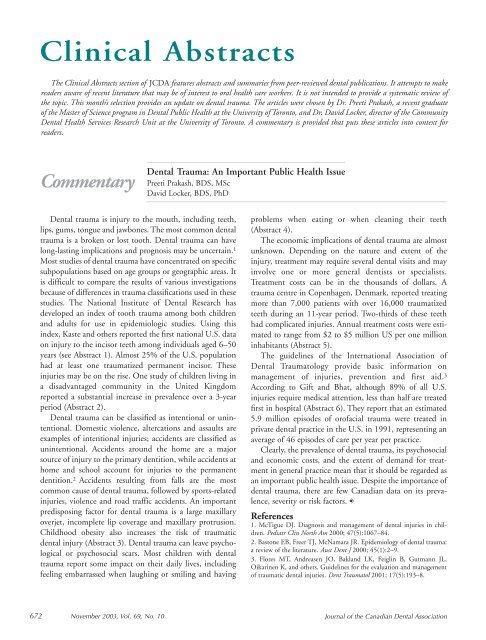JCDA - Canadian Dental Association
JCDA - Canadian Dental Association
JCDA - Canadian Dental Association
Create successful ePaper yourself
Turn your PDF publications into a flip-book with our unique Google optimized e-Paper software.
Clinical Abstracts<br />
The Clinical Abstracts section of <strong>JCDA</strong> features abstracts and summaries from peer-reviewed dental publications. It attempts to make<br />
readers aware of recent literature that may be of interest to oral health care workers. It is not intended to provide a systematic review of<br />
the topic. This month’s selection provides an update on dental trauma. The articles were chosen by Dr. Preeti Prakash, a recent graduate<br />
of the Master of Science program in <strong>Dental</strong> Public Health at the University of Toronto, and Dr. David Locker, director of the Community<br />
<strong>Dental</strong> Health Services Research Unit at the University of Toronto. A commentary is provided that puts these articles into context for<br />
readers.<br />
Commentary<br />
<strong>Dental</strong> trauma is injury to the mouth, including teeth,<br />
lips, gums, tongue and jawbones. The most common dental<br />
trauma is a broken or lost tooth. <strong>Dental</strong> trauma can have<br />
long-lasting implications and prognosis may be uncertain. 1<br />
Most studies of dental trauma have concentrated on specific<br />
subpopulations based on age groups or geographic areas. It<br />
is difficult to compare the results of various investigations<br />
because of differences in trauma classifications used in these<br />
studies. The National Institute of <strong>Dental</strong> Research has<br />
developed an index of tooth trauma among both children<br />
and adults for use in epidemiologic studies. Using this<br />
index, Kaste and others reported the first national U.S. data<br />
on injury to the incisor teeth among individuals aged 6–50<br />
years (see Abstract 1). Almost 25% of the U.S. population<br />
had at least one traumatized permanent incisor. These<br />
injuries may be on the rise. One study of children living in<br />
a disadvantaged community in the United Kingdom<br />
reported a substantial increase in prevalence over a 3-year<br />
period (Abstract 2).<br />
<strong>Dental</strong> trauma can be classified as intentional or unintentional.<br />
Domestic violence, altercations and assaults are<br />
examples of intentional injuries; accidents are classified as<br />
unintentional. Accidents around the home are a major<br />
source of injury to the primary dentition, while accidents at<br />
home and school account for injuries to the permanent<br />
dentition. 2 Accidents resulting from falls are the most<br />
common cause of dental trauma, followed by sports-related<br />
injuries, violence and road traffic accidents. An important<br />
predisposing factor for dental trauma is a large maxillary<br />
overjet, incomplete lip coverage and maxillary protrusion.<br />
Childhood obesity also increases the risk of traumatic<br />
dental injury (Abstract 3). <strong>Dental</strong> trauma can leave psychological<br />
or psychosocial scars. Most children with dental<br />
trauma report some impact on their daily lives, including<br />
feeling embarrassed when laughing or smiling and having<br />
672 November 2003, Vol. 69, No. 10<br />
<strong>Dental</strong> Trauma: An Important Public Health Issue<br />
Preeti Prakash, BDS, MSc<br />
David Locker, BDS, PhD<br />
problems when eating or when cleaning their teeth<br />
(Abstract 4).<br />
The economic implications of dental trauma are almost<br />
unknown. Depending on the nature and extent of the<br />
injury, treatment may require several dental visits and may<br />
involve one or more general dentists or specialists.<br />
Treatment costs can be in the thousands of dollars. A<br />
trauma centre in Copenhagen, Denmark, reported treating<br />
more than 7,000 patients with over 16,000 traumatized<br />
teeth during an 11-year period. Two-thirds of these teeth<br />
had complicated injuries. Annual treatment costs were estimated<br />
to range from $2 to $5 million US per one million<br />
inhabitants (Abstract 5).<br />
The guidelines of the International <strong>Association</strong> of<br />
<strong>Dental</strong> Traumatology provide basic information on<br />
management of injuries, prevention and first aid. 3<br />
According to Gift and Bhat, although 89% of all U.S.<br />
injuries require medical attention, less than half are treated<br />
first in hospital (Abstract 6). They report that an estimated<br />
5.9 million episodes of orofacial trauma were treated in<br />
private dental practice in the U.S. in 1991, representing an<br />
average of 46 episodes of care per year per practice.<br />
Clearly, the prevalence of dental trauma, its psychosocial<br />
and economic costs, and the extent of demand for treatment<br />
in general practice mean that it should be regarded as<br />
an important public health issue. Despite the importance of<br />
dental trauma, there are few <strong>Canadian</strong> data on its prevalence,<br />
severity or risk factors. C<br />
References<br />
1. McTigue DJ. Diagnosis and management of dental injuries in children.<br />
Pediatr Clin North Am 2000; 47(5):1067–84.<br />
2. Bastone EB, Freer TJ, McNamara JR. Epidemiology of dental trauma:<br />
a review of the literature. Aust Dent J 2000; 45(1):2–9.<br />
3. Flores MT, Andreasen JO, Bakland LK, Feiglin B, Gutmann JL,<br />
Oikarinen K, and others. Guidelines for the evaluation and management<br />
of traumatic dental injuries. Dent Traumatol 2001; 17(5):193–8.<br />
Journal of the <strong>Canadian</strong> <strong>Dental</strong> <strong>Association</strong>

















